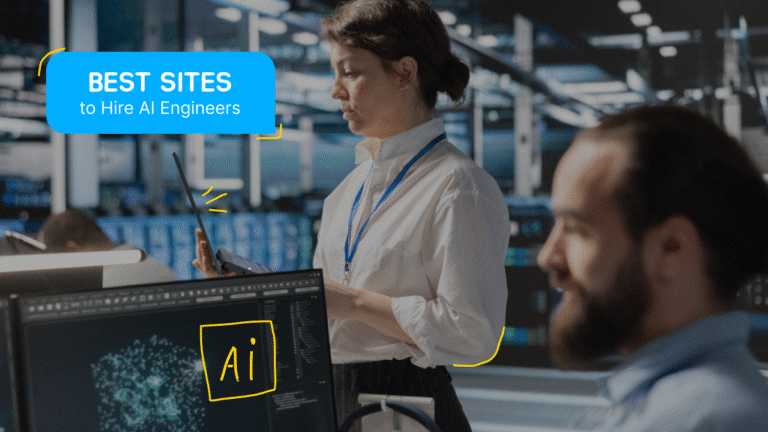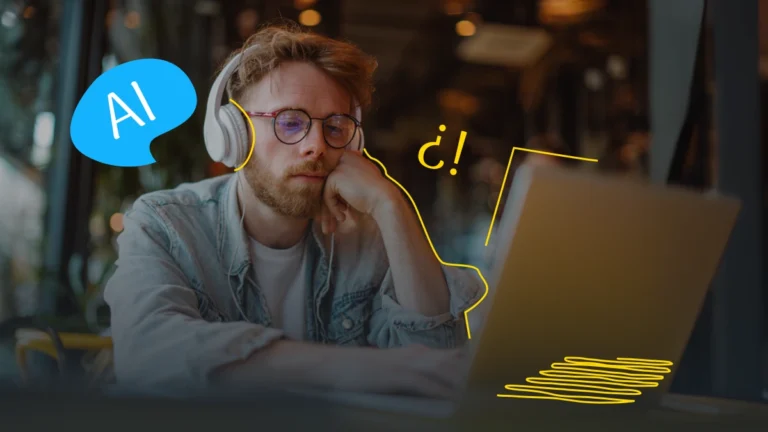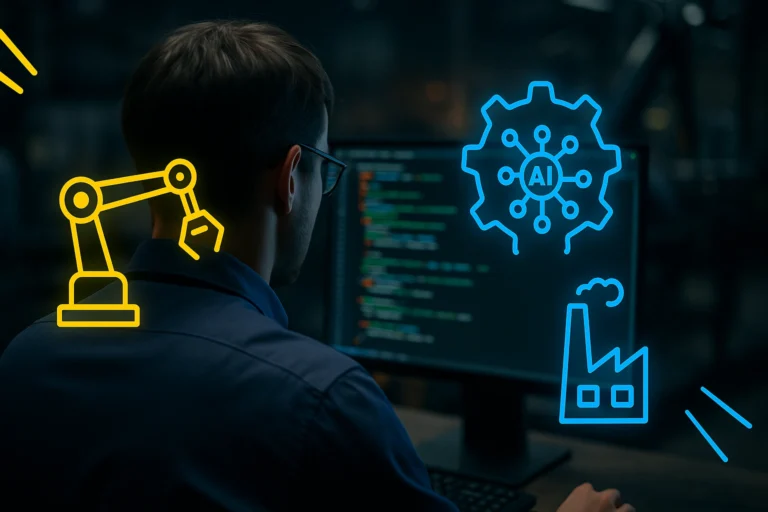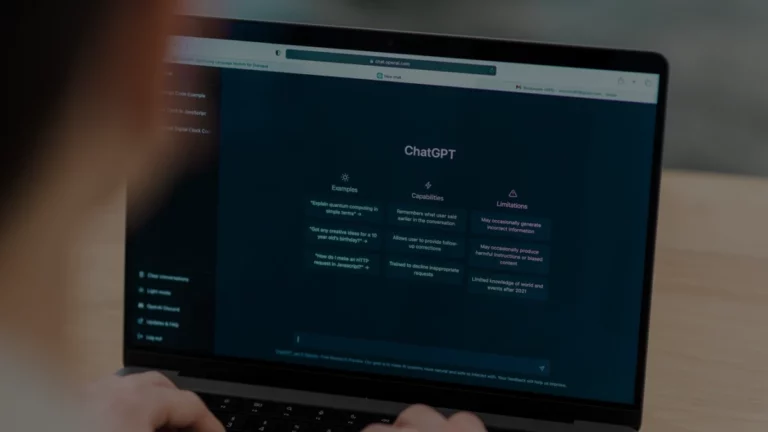AI Use Cases in Healthcare: What’s Possible Today and What’s Coming Next
- 7 Ways Artificial Intelligence Is Changing Healthcare
- Main Benefits of Artificial Intelligence in Healthcare Operations
- Challenges of Implementing Generative AI in Modern Healthcare
- How Mobilunity Helps AI Healthcare Organization: Client Overview
- The Challenge: Seamless Integration and Task Automation
- What Can the AI-Powered Chatbot Used in the Healthcare Industry Do?
- Mobilunity’s Solution: Building a Collaborative Partnership to Transform Healthcare
- Results: Enhanced Patient Engagement, Medical Research, and Operational Efficiency
- Developer Retention: Ensuring Long-Term Success
- Client Testimonial: A Successful Long-Term Partnership
- Let’s Talk About Your AI Use Case in Healthcare
In the healthcare industry, offering timely and convenient patient support is essential. As telehealth continues to evolve, patients expect real-time access to services and information, making AI chatbots crucial in enhancing the patient experience. Such chatbots enable users to ask questions, schedule appointments, manage prescriptions, and receive tailored health recommendations through casual conversations.
Mobilunity recently partnered with a U.S. startup healthcare company to implement an AI-powered chatbot designed to revolutionize patient interactions with the healthcare system. This case study highlights the details of our cooperation with the client, the challenges we faced, and how our dedicated AI team helped deliver an innovative solution that exceeded expectations.
7 Ways Artificial Intelligence Is Changing Healthcare
Artificial intelligence used to sound like sci-fi talk, but now it’s everyday tech in hospitals and clinics. From speedy diagnoses to care made just for you, here are seven big ways AI is shaking up medicine.

1. Smarter Diagnostics: AI That Sees What Humans Might Miss
Doctors used to trust only their eyes and instincts, but that is changing fast. Now, smart programs study X-rays, MRIs, and CT scans and flag details even top specialists could overlook.
What AI brings to diagnostics:
- Checks images for early signs of trouble, such as cancer, fractures, or tumors
- Spots tiny glitches quicker than old-school methods
- Recommends next steps based on what it finds
Real-world example: Some AI applications already flag breast and lung cancers as accurately or better than seasoned radiologists.
2. Personalized Medicine: One Patient, One Plan
These days, healthcare stops trying to fit everyone into the same mold. With AI at the wheel, doctors draft plans using your genes, daily habits, and records instead of handing you a broad rule book.
How AI personalizes care:
- Scans your DNA and spots hidden risk spots
- Picks the right pill and fine-tunes the dose just for you
- Guess-es how your body will handle a treatment over time
Benefit: Fewer nasty surprises and better results, because the care is really, truly yours.
3. Remote Monitoring: AI Keeps an Eye on You (In a Good Way)
Forget creepy cameras; today’s AI in healthcare is a friendly watcher, using wearables and mobile sensors to check in from your living room, especially when chronic illness is on board.
What AI does in remote care:
- Records heart rate, blood sugar, oxygen, the whole shortlist
- Dings a warning when numbers drift the wrong way
- Pings the doctor so help shows up early
Example: A slight jump in blood sugar can spark a quick text, letting you adjust before a full-blown ER trip.
4. Faster Drug Discovery: From Decades to Days
Making a new pill once chewed up ten years or more and cost a fortune. Thanks to AI, that snail march is now a fast walk.
AI’s role in pharma:
- It sifts through chemical and DNA records, scouting new drug ideas.
- It spots links between illnesses and fixes faster than any lab crew.
- It runs virtual body tests, showing how a drug might behave long before patients are involved.
Example: AI can guess which molecules latch onto a virus protein, cutting weeks off vaccine work.
5. AI-Assisted Surgery: Precision at Every Cut
Don’t worry Smart Helper isn’t taking the scalpel; it’s making the person behind it sharper. By watching heart rate, bleeding, and every twitch in real-time, AI nudges the team toward safer, steadier work.
Benefits of robot-assisted surgery with AI:
- It zooms in, highlighting blood vessels or tumors the eye might miss.
- It highlights the cleanest slice or the least trauma entry.
- It flashes warnings when vital signs dip before the crew even sees them.
Outcome: Patients get safer surgeries, less scarring, and faster recoveries.
6. Virtual Assistants & Chatbots: 24/7 Health Support
Tired of waiting on hold to talk to your doctor’s front desk? AI-powered helpers step in at any hour you need them.
How they help:
- They reply to simple health questions day or night.
- They book appointments or refill prescriptions without waiting.
- They check symptoms and nudge you with pill alerts.
Bonus: By tackling routine chats, they save clinic hours, letting the real staff focus on care.
7. Administrative Automation: Less Paperwork, More People Care
Behind every exam room visit stacks of forms and notes. AI steps in to handle that grunt work so the team can spend more time treating patients.
AI takes over tasks like:
- Booking and confirming appointments
- Entering claims and running invoices
- Spotting patterns in supply use
Impact: Clinics run smoother, staff feel less swamped, and patients enjoy quicker, friendlier service.
Summary Table: AI’s Impact on Healthcare Sector
| Area | AI Contribution | Benefit |
| Diagnostics | Analyzes scans and images | Faster, more accurate diagnoses |
| Personalized Medicine | Tailors treatment to DNA/lifestyle | Better outcomes, fewer side effects |
| Remote Monitoring | Uses wearables to track health | Early detection, fewer hospital visits |
| Drug Discovery | Predicts compounds and interactions | Speeds up new drug development |
| Surgery | Enhances precision and visual feedback | Safer, faster recoveries |
| Virtual Assistants & Chatbots | 24/7 health help via mobile or web | Easier access to information and services |
| Admin Automation | Handles scheduling, billing, and more | Saves time, reduces staff burnout |
Main Benefits of Artificial Intelligence in Healthcare Operations
Artificial intelligence is shaking up healthcare, helping doctors, nurses, and even patients at every step. From spotting illness to streamlining supply rooms, AI is proving itself useful in surprising ways.
1. Sharper Diagnoses and Care Plans
Unlike people, machines can scan mountains of data in seconds, catching details a busy doctor might miss. Because of that speed, AI supports:
- Earlier warnings for cancers, heart problems, and brain issues
- Clearer calls on whether an X-ray shows a fracture or just a shadow
- Care plans built around each person’s health history and genes
The result is faster choices and, more often than not, healthier patients.
2. Streamlined Day-to-Day Hospital Work
Smart software handles the boring paperwork so doctors and nurses spend less time clicking and more time caring.Automation steps in for:
- Booking appointments and sending reminders
- Updating charts and entering lab results
- Checking coverage and filing claims
With smoother routines and fewer logjams, hospitals see more patients and spend less money.
3. Faster Drug Research and Testing
AI sifts through mountains of lab data to help scientists:
- Spot new molecules to test
- Guess how well a drug might work
- Flag side effects long before people swallow a pill
That shrinks the wait for fresh medicines and better odds in the clinic.
4. Smarter Clinical Trials
AI scans records, genes, and test results to find volunteers who are most likely to improve with a new treatment.
Benefits include:
- Smarter, leaner trial designs
- Shorter timetables and lowered costs
- Better safety and clearer patient outcome forecasts
5. Better Patient Safety
Patient safety climbs when AI spots and stops mistakes before they occur. Smart tools can:
- Warn about risky drug combos or wrong doses
- Signal caregivers when vitals swing off-course
- Point out trouble spots before they blow up
This forward-thinking watchfulness cuts preventable harm and earns patient trust.
6. Streamlined Administrative Workflows
AI is useful beyond surgery-its reshaping the mountain of paperwork, too.
Examples include:
- Voice-to-text notes created in real-time
- Smart help with coding and billing
- Instant sharing of test results between units
Because of these helpers, doctors log fewer hours on forms and more hours at the bedside.
7. Virtual Nursing Assistants
AI-powered nurse apps and chatbots are on duty around the clock. Research shows more than 60% of patients are fine using them for:
- Drug reminders and dosing tips
- Symptom check-in
- Booking follow-up visits
These digital sidekicks lift some of the clinical load and keep people active in their care.
8. Safer, Less Invasive Surgeries
AI-powered surgical robots are showing up more often in operating rooms, especially when doctors work in tight or fragile spots. The perks include:
- Sharper cuts that follow the plan
- Tiny wounds, so blood loss and infection drop
- Faster healing and less visible scars
While the surgeon stays in control, onboard AI displays live images and quick notes that boost trust and accuracy.
9. Fraud Detection and Prevention
Smart analytics now skim every claim and bill, flagging anything that smells off so clinics and insurers can catch it:
- Unneeded or phony treatments
- Charges that show up twice
- Split services and code mix-ups
Nipping these problems in the bud saves money and keeps patient care honest.
10. Optimized Supply Chain Management
By reading trends, AI hopes to keep shelves stocked without drowning in extras. Advantages include:
- Spot-on forecasts for bandages, gloves, and high-tech gear
- Less waste and lower haul-away bills
- Vital drugs and tools are ready when patients need them

Challenges of Implementing Generative AI in Modern Healthcare
Gen AI can do amazing things in healthcare, from backing up doctors in tough choices to tailoring reminders for each patient. Yet, that promise comes with a tangle of real-world problems. For these tools to work smoothly, hospitals and clinics have to juggle questions about privacy, tech talk, and much more. Here are the biggest hurdles on that path.
1. Bias in AI Solutions
AI algorithms by chewing through past data. If that data misses whole groups or carries hidden stereotypes, the output can widen the gap instead of closing it.
Key concerns:
- Unequal diagnostic or treatment advice for different patients.
- Tools that simply fail when they meet a new age or ethnic group.
How to address it:
- Gather broad, balanced datasets from every corner of the patient population.
- Test, retest, and watch for bias long after the launch.
- Stick to tough validation rules at every step of model building.
2. Data Privacy & Security
AI thrives on data, and healthcare information is some of the most private there is. When names, diagnoses, and treatment plans become the fuel for a model, keeping that information locked up is not optional. Attackers and leaks can harm patients and ruin trust in digital medicine.
Primary risks:
- Unapproved people getting into patient files
- Leaks or mishandling of health information
- Using names or images without clear permission
Best practices:
- Use full-disk encryption and give each team member only the access they need
- Follow HIPAA, GDPR, and any local privacy rules
- Strip out names and other IDs before training any AI program
- Write simple, firm rules about how files are stored, who can see them, and when they can be shared
3. Compliance & Regulatory Challenges
Healthcare has more red tape than almost any other field, and adding AI to daily work means untangling a long chain of approvals, standards, and best-practice manuals.
Compliance considerations:
- Get FDA or EMA sign-off if the AI tool is treated like a medical device
- Alignment with ethical AI frameworks (e.g., FUTURE-AI, WHO guidance)
- Stay within privacy laws and rules for safe medical practice
What organizations must do:
- Bring in lawyers and compliance officers at the first planning meeting
- Partner with regulators early so certification moves fast
- Keep clear records of how the model is built, tested, used, and limited
4. Integration of AI with Existing Systems
Most hospitals still run aging IT networks that were never meant for AI, so plugging a new generative model into that patchwork can break equipment and frustrate staff.
Common issues:
- Lack of interoperability between AI and electronic health records (EHR)
- New tech interrupts daily tasks, and many doctors just push back.
- Patient records get locked in silos, blocking smooth AI work.
Solutions:
- Before adding anything, map and test the whole IT setup.
- Pick AI apps that already speak the same data language.
- Teach staff to use, question, and trust the new helpers.
- Build AI around existing routines, not on top of them.
5. Accuracy and Reliability with Patient Data
Gen AI, while powerful, is not infallible. These models can sometimes generate incorrect or misleading outputs – referred to as “hallucinations” – which is particularly risky in high-stakes clinical environments like oncology or critical care.
Risks:
- Wrong diagnoses or bad advice slip through the cracks.
- Doctors start doubting what the screen shows.
How to mitigate:
- Ensure human oversight remains part of the clinical decision process
- Prioritize transparent, explainable AI models
- Continuously monitor model performance in real-world settings

Generative AI can rewrite medicine for the better, yet hurdles remain. Keeping data safe, winning clinician trust, and proving accuracy all take work beyond smart code.
To clear these roadblocks, hospitals and clinics need smart people, solid tools, and a clear game plan. Working with seasoned AI specialists who know health care inside and out can turn shiny tech dreams into real benefits at the bedside.
How Mobilunity Helps AI Healthcare Organization: Client Overview
As a healthcare provider, the client understood the increasing need for digital patient assistance. They wanted a way to elevate the patient experience by providing 24/7 access to health-related information, automating routine tasks like scheduling, and ensuring secure, personalized interactions. However, they needed a team with the right expertise to bring this solution to life.
| Company’s name | Under NDA |
| Industry | Healthcare Services |
| Location | United States |
| Duration | Ongoing |
| Technologies | AI, ML, NLP, Python, AWS, Docker |
| Product | AI-powered chatbot for patient engagement |
| Target users | Patients looking for information, appointment scheduling, prescription management, and health monitoring |
| Team staffed | AI Developer, Data Scientist, Backend Developer |
The Challenge: Seamless Integration and Task Automation
The client faced numerous challenges during the implementation of an AI-powered chatbot for their patients.
| Challenge | Details |
| Finding Experienced Talent | The need for AI developers with natural language processing (NLP) expertise and healthcare knowledge was urgent. |
| Integration with Legacy Systems | The chatbot had to work seamlessly with the client’s Electronic Health Records (EHR) system and appointment scheduling platform. |
| Data Security and Compliance | The AI system had to comply with HIPAA regulations to ensure patient data security while providing personalized, real-time responses. |
Alongside these challenges, the chatbot needed to maintain an intuitive, user-friendly interface with simple navigation for patients.
Mobilunity’s solution was to provide a dedicated team of Artificial Intelligence developers, equipped with the necessary expertise to navigate these challenges while ensuring seamless integration and compliance with healthcare standards.
What Can the AI-Powered Chatbot Used in the Healthcare Industry Do?
The chatbot we created for the client, driven by AI, provides various functionalities to improve the patient experience and provide personalized medicine:
- Support available 24/7. Patients can receive support at any time, obtaining immediate replies to their health inquiries.
- Scheduling appointments. The chatbot enables patients to conveniently book, modify, or cancel appointments.
- Prescription oversight. Patients can ask for prescription refills and receive notifications for upcoming refills.
- Tailored health suggestions. According to patient information, the chatbot provides alarms on time to take prescribed medicine.
- Symptom prioritization. The chatbot can evaluate symptoms and suggest subsequent actions, like deciding if immediate care is necessary.
- Safe data management. Every interaction adheres to HIPAA guidelines, guaranteeing the protection of patient information.
- Collaboration with medical systems. The chatbot connects with EHR and scheduling systems to enhance workflows and deliver updates in real-time
Mobilunity’s Solution: Building a Collaborative Partnership to Transform Healthcare
Clients describe Mobilunity as a business that delivers technical services in the form of an expertise. While this is true, at Mobilunity, we strive to build a long-term partnership with our clients. Our approach to this project went beyond delivering technical specialists; we aimed to foster a cooperative relationship that would ensure the client’s long-term success.
1. Hiring Process: Matching Talent to the Client’s Needs
To identify suitable developers, we established a tailored hiring process that guaranteed we attracted the most fitting candidates for the project.
Step-by-Step Hiring Process
Developing Artificial Intelligence in healthcare requires engineers with different knowledge, experience, and tech expertise. To hire specialists who can build the AI platform following all the requirements we made necessary steps (you can find them in the table below).
The whole process took only six weeks from the first call with the client to the signed job offer.
| Step | Overview |
| Initial Consultation | A 45-minute meeting with the client to grasp the unique requirements for the AI-driven chatbot and its integration with healthcare systems. |
| Talent Acquisition | We identified developers proficient in NLP, chatbot technologies, and familiar with healthcare information systems such as EHR and HIPAA regulations. |
| Candidate Evaluation | With a client, we performed thorough technical evaluations to assess every candidate’s expertise in AI, healthcare systems, and security protocols. |
| Team Composition | We gathered a committed group of AI Developers, Data Scientists, and Integration Experts to develop the chatbot and guarantee seamless integration. |
Team We Helped Hire
We helped the client hire three healthcare professionals with the required expertise and experience with chatbot development.
Below is a quick overview of the AI talents we hired.
| Role | Expertise | Responsibilities | Allocation |
| AI Developer (NLP & Machine Learning) | Natural Language Processing (NLP), Machine Learning | – Designed core NLP capabilities for the chatbot – Ensured accurate understanding of patient queries and context-aware responses – Implemented NLP techniques for healthcare-related queries | Full-time, dedicated to chatbot NLP features |
| Data Scientist (Healthcare DataIntegration & Security) | Healthcare DataIntegration, Data Security | – Integrated the chatbot with the client’s EHR system – Ensured HIPAA compliance and data security for patient information – Worked with healthcare standards such as FHIR and HL7 | Full-time, dedicated to data integration and compliance |
| Backend Developer (System Integration & Automation) | Backend Development, Cloud Solutions | – Led backend development and system integration with the client’s existing systems – Automated workflows for scheduling and prescription management – Set up cloud infrastructure and ensured scalability using AWS, Docker, and Kubernetes | Full-time, dedicated to backend integration and automation |
2. Onboarding: Ensuring Smooth Integration and Team Alignment
After the team was brought on board, our efforts centered on training them to ensure they blended effortlessly into the client’s current workflows. This was essential for fostering a cooperative atmosphere and making sure the project advanced seamlessly.
| Onboarding Activity | Information |
| Team Integration | We incorporated the team into the client’s Slack, Jira, and Trello for effective collaboration and task monitoring. |
| Healthcare Compliance Training | Our team received comprehensive training on HIPAA regulations and client-specific healthcare systems. |
| Knowledge Transfer | Enabled effective knowledge transfer from the client’s internal team, making sure our developers comprehended their current tools and processes. |
| Iterative Development | We embraced an agile development methodology with ongoing feedback cycles, allowing the team to enhance the chatbot’s features and performance. |
Results: Enhanced Patient Engagement, Medical Research, and Operational Efficiency
The chatbot effectively met the client’s main goals, enhancing both patient involvement and operational productivity:
| Metric | Before Chatbot | After Chatbot | Improvement |
| Patient query response time | 30-60 minutes per inquiry | Instant response | 100% faster |
| Appointment scheduling time | 5-10 minutes per appointment | Instant scheduling via chatbot | 80% faster |
| Prescription refill process | Manual processing | Automated refill requests | 90% reduction in manual handling |
| Patient satisfaction | 70% satisfied | 95% satisfaction rate | 25% increase |
| Operational efficiency | Manual coordination required | Fully automated workflow | 50% time savings |
The chatbot now offers round-the-clock access to health data, appointment booking, and prescription handling, minimizing patient wait periods and allowing healthcare personnel to concentrate on more intricate responsibilities. Patients indicated greater satisfaction with the system’s convenience and user-friendliness.
Developer Retention: Ensuring Long-Term Success
At Mobilunity, we focus on retaining developers to guarantee lasting success and uphold a high standard of quality in each project.
Our client faced challenges in effectively managing a remote development team. Due to new technologies and processes, they required a solution that would boost productivity, improve employee retention, and promote better collaboration among their internal and remote teams.
What have we done?
- Optimized performance assessments. We established a clear and organized assessment procedure for every team member. This involved routine performance evaluations, continuous goal monitoring, and steady feedback directly from clients to guarantee clear advancement.
- Established distinct, tailored objectives. Based on the evaluation outcomes, we collaborated closely with the client to develop personalized growth roadmaps. These encompassed customized objectives, quantifiable benchmarks, and distinct growth anticipations to synchronize team members with the organization’s aims.
- Promoting employee involvement. We implemented organized employee engagement programs, including team-building activities, social gatherings, and reward schemes. This fostered a collaborative and supportive atmosphere, enhancing a positive work culture.
- Enabled open communication between client and team. To enhance collaboration and coherence, we initiated regular one-on-one meetings and created efficient reporting mechanisms. This facilitated smooth interaction between the client and their remote team, ensuring everyone stayed aligned.
- Improved retention through attractive compensation. We assisted the client in conducting compensation reviews every six months and on an annual basis. This involved providing attractive salaries, bonuses tied to performance, and evident opportunities for career growth to sustain high motivation and retention rates.

The chatbot utilizing AI has notably enhanced patient interaction and optimized administrative functions for the healthcare provider. The chatbot has achieved efficiency and patient satisfaction by offering 24/7 access, automating standard procedures, and maintaining regulatory compliance.
Client Testimonial: A Successful Long-Term Partnership
The client expressed their contentment with the outcomes
Let’s Talk About Your AI Use Case in Healthcare
Do you want to improve patient involvement with a solution powered by AI? Reach out to Mobilunity now, and allow us to supply you with the expertise required to create and execute cutting-edge, scalable solutions.













